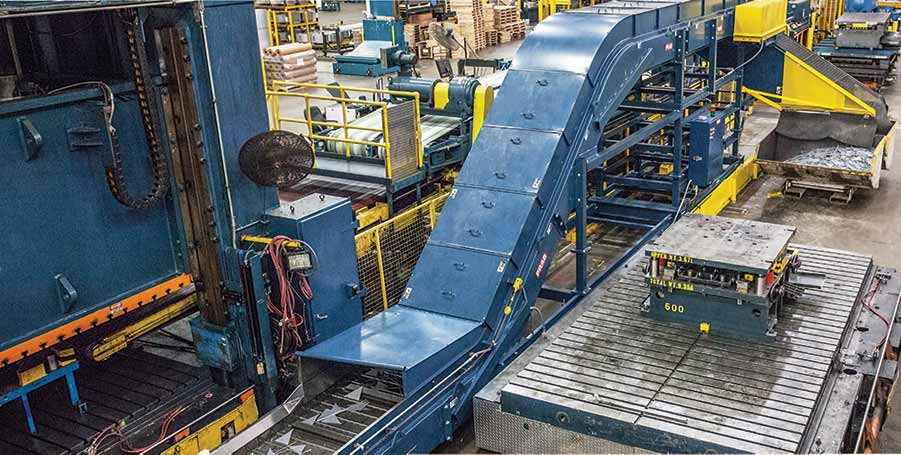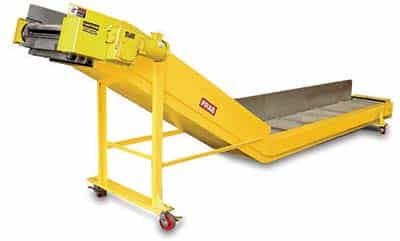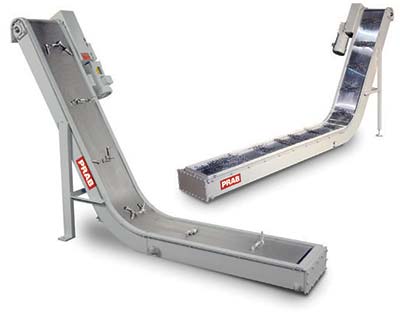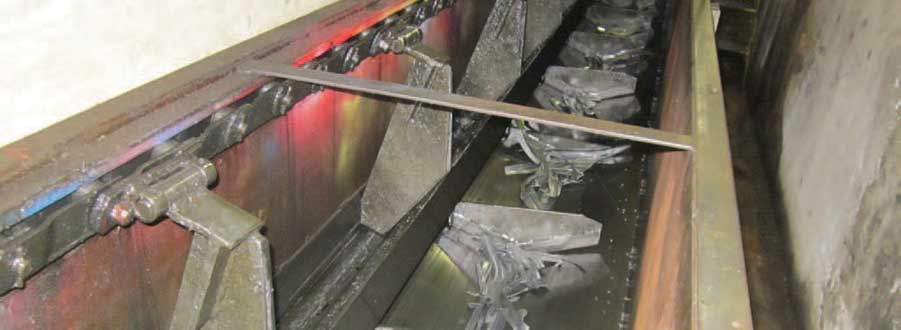
Conveyors are said to be the workhorses of production. The conveyors used to move metal scrap are no exception, but they are a breed all their own. They are designed to meet unique application criteria including load weight, volume, transfer distance, material composition, wet vs. dry material, and flowability; metalworking conveyors are not one size fits all.
Unfortunately, conveyor breakdowns are a frequent cause of downtime in metalworking. With automation on the rise, the market for these important material-handling systems is projected to grow significantly.1 As operators usher in process upgrades, increasing the utilization rate for metalworking conveyors by reducing downtime is a necessary step toward improving operations.
Carryover, also called carryback, is one of the leading causes of unscheduled conveyor downtime in metalworking. When material is pulled back down the return side of the unit because the scrap on the belt did not discharge from the end of the conveyor, maintenance is required to remove this material and perhaps repair damaged equipment. Unless carryover is a chronic problem that causes operators to perform maintenance on daily or weekly intervals, carryover maintenance is usually unplanned.
When it comes to discharging metal scrap, some conveyor belts are more prone to carryover than others. Steel beltconveyors, for example, are more susceptible to carryover because of how the belt is constructed. Because the conveyor is composed of a series of pans with gaps between each pan, material is subject to lodging between the individual pans and not discharging from the end of the conveyor.
Two styles of conveyors are designed to eliminate metal scrap carryover: magnetic conveyors and pivot belt conveyors.

Magnetic conveyor: Ferrous metal scrap sticks to the conveyor via magnets below a stainless steel slide plate. When the metal scrap reaches the end of the conveyor, the material cleanly discharges as the magnets lose contact with the slide plate.

Two common problems arise with payloads: they become too heavy or the conveyor can’t consistently move certain types of metal scrap due to the composition of the material.
Conveyors have weight limits. Pushing conveyors beyond their payload capabilities is one of the most common ways operators jeopardize the equipment. When loads become too heavy, motors become overloaded. Moving loads that strain the conveyor may result in equipment damage.
Bushy bundles are another frequent cause of downtime for metalworking operations. When loaded onto screw/auger conveyors, the bundles often fail to follow the feed of the auger. Instead, they bounce around inside the in-feed hopper. This often forces operators to manually break the bundles apart so the auger can transfer the material. This step contributes to inefficient processing, wastes resources, and is unsafe.
To avoid damaging a conveyor by overtaxing its motor, choose a conveyor that will automatically shut the conveyor down when a load exceeds the conveyor’s capabilities. PRAB’s Pivot Belt Conveyor, for example, comes standard with torque-limiting protection and no-rotation sensing as safeguards.
To overcome problematic bundles, pre-condition them prior to material transfer. Auxiliary systems, such as PRAB’s Bundle Breaker, tear bundles into smaller pieces before the bundle of metal scrap is fed to the auger. This additional step allows the auger to consistently move the metal scrap without intervention from an operator.
If a conveyor isn’t built to provide a long service life, structural deficiencies will contribute to increased maintenance and unplanned downtime. Routine maintenance also increases for metal scrap conveyors that fail to incorporate features and options designed to streamline recurring maintenance tasks.
Partnering with a material-handling solutions provider that is committed to fabricating long-lasting equipment will enable you to get the most value from your metalworking conveyor investment. For example, PRAB engineers its conveyors to include the following design enhancements:
To decrease the frequency of routine conveyor maintenance, choose a conveyor that includes a lube system that automatically greases bearings. Also utilize controls that provide maintenance schedule alerts and remote monitoring systems, which can advise maintenance operators to potential issues without them having to physically be near the equipment.

A metal scrap conveyor that is not optimized for the application will ultimately result in inefficient processing, more maintenance, and higher labor costs. By choosing a conveyor that eliminates carryover, consistently transfers challenging payloads, and is engineered to reduce routine maintenance, metalworking operations position their facility to increase uptime on their back-end processes.
1 Conveyor Systems Market to Hit USD 7.43 billion by 2027; Increasing Emphasis on Reducing Labor Costs in Factories Worldwide to Aid Market Growth: Fortune Business Insights™, April 2021, https://www.globenewswire.com/news-release/2020/07/01/2056409/0/en/Conveyor-Systems-Market-to-Hit-USD-7-43-billion-by-2027-Increasing-Emphasis-on-Reducing-Labor-Costs-in-Factories-Worldwide-to-Aid-Market-Growth-Fortune-Business-Insights.html